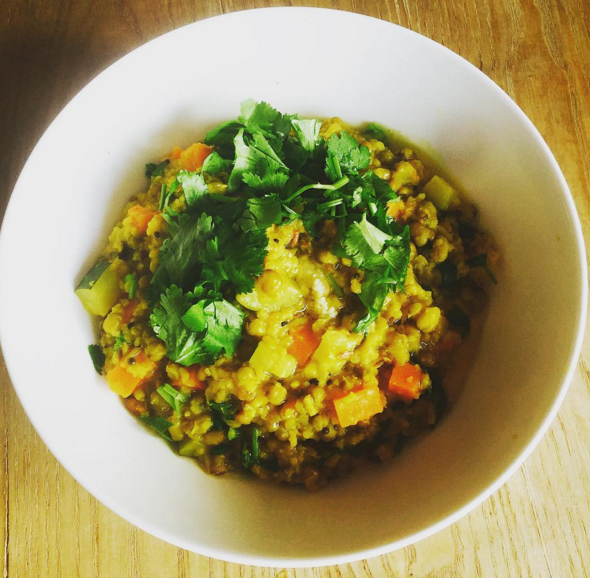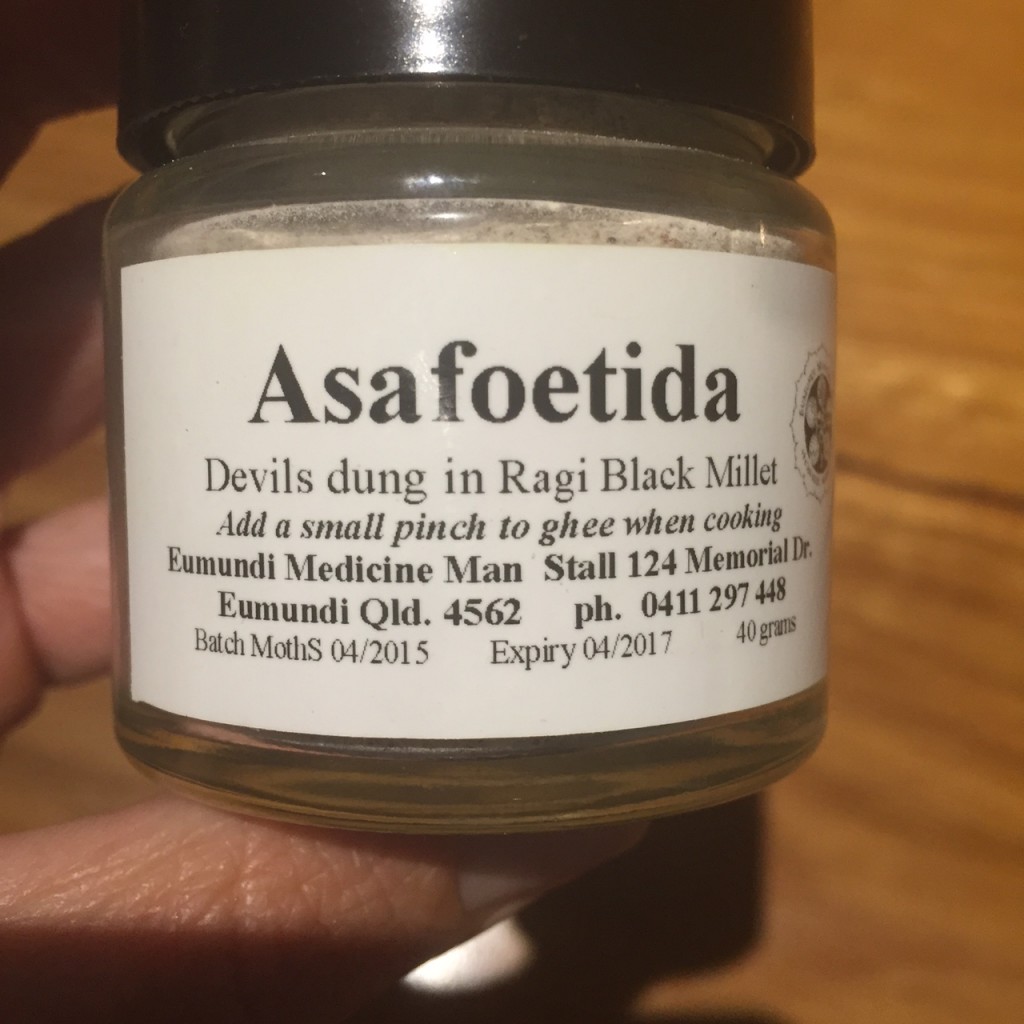First, what is this kitcheri (pronounced kich-ah-ree) stuff I speak of rather often. (I have a recipe for Nourishing Kitcheri in I Quit Sugar For Life and an Inside-Out Sprouted Kitcheri Loaf in Simplicious; I also shared how I ate it at the Indian retreat I did some time back.)

In Ayurveda this mung and rice curried bowl of sweet, soft, soupy goodness is considered the ultimate digestion-healing and detox food. It’s warming, soft, light and designed to fire up your digestive energy, or “agni”, via a bunch of select spices. Indeed, it’s served in clinics when people are sick and is used for cleansing purposes (where you eat it breakfast, lunch and dinner).
But it’s a whole lotta grains and legumes!
I know, I know. The stuff is made from mung daal and basmati rice.
At first, I was dubious. I bloat up from such foods normally and tend to avoid them. But consumed in this combo, with the spices and ghee that’s added, something mysterious happens and I’ve found that when I do eat it, my digestion is pacified. Almost immediately.
I asked Ayurvedic consultant Nadia Marshall to explain the deal from an Ayurvedic perspective:
“Both mung daal and basmati rice are light in quality with a predominantly sweet taste (mung is also astringent), a cooling digestive effect and a sweet post-digestive effect. It is quite rare to have foods that are sweet/cooling/sweet… but also light. As a result, mung daal and basmati rice have the special quality of being nourishing for the tissues and immune system but also light and easy to digest. Mung and basmati’s sweet quality (both as their taste and post-digestive effect) has a calming, grounding effect on the mind/body but is also considered Sattvic which means it helps to directly cultivate peace, clarity and contentment in the mind. They are both also balancing to all of the doshas (Vata, Pitta and Kapha).”
But white rice?
It’s easier to digest than brown. I’m not a fan of the latter due to the very high levels of phytic acid in the bran and advocate basmati in my cookbooks. As it turns out.
Why mung daal?
Well, it’s the only lentil/legume that doesn’t produce intestinal gas. I can vouch for this, after years of testing the theory. Plus, the combination of basmati rice and mung adds up to a complete protein.
Says Nadia: “From a western perspective, mung beans are considered alkaline because they have high quantities of predominantly alkaline minerals – calcium, magnesium, potassium and sodium. They are also rich in Vitamin C, are quite high in protein (24g/100g) and also fibre (16g/100g). As a result, they have a low GI of just 31 (which is reduced further when they’re cooked with ghee).”
What else goes into it?
Most kitcheri recipes use mustard seeds, turmeric, asafetida, curry leaves, cumin. You can buy these in speciality food stores (and most supermarkets) or Indian food outlets. All of these spices help to support digestion and many of them are specific for reducing vata indigestion and gas.

Says Nadia: “These spices, combined with salt, a squeeze of lemon juice and some fresh coriander leaves help to give kicharee a balance of the six tastes – sweet, sour, salty, pungent, bitter and astringent.” This balance is key in Ayurveda. As I’ve shared before, balance (not “fixing”) is what Ayurvedic medicine aims for.
Why do I eat it?
I go through patches where my gut is struggling. I make a batch and eat it over several days (although, note that Ayurveda advocates eating food fresh, not keeping leftovers) and do notice a shift.
Plus, as I mention in my Instagram post, I use kitcheri as a vehicle for eating a whole lot of turmeric and coriander. Both are the bomb for anyone with inflammation issues and is very useful for anyone who’s got heavy metal poisoning and is trying to chelate (I do; long story which I’ll share shortly).
My simple version.
Wonderfully true kitcheri must be kept simple to be healing. I’ve played around with all sorts of versions. Here’s the almost “cheat” version I’ve come up with, that keeps to the “simple for the digestion” vibe, uses less dishes and less fancy ingredients that you have to buy from scratch, while oomphing the nutritional profile as much as possible.
I use:
Basmati and green mung. Both are soaked for several hours to help with digestion.
Panch Phora. This combines all the crucial spices into one easy mix – less waste.
Asafetida. This is the gum resin that comes from the root of several species of an Eastern herb and is a flavour substitute for garlic. A small tin is about $5-$8 and lasts a long time.
Curry leaves. These things are great and won’t go to waste once you get a taste for them. I like to pan fry curry leaves and mustard seeds in ghee or coconut oil and added diced veg for a simple lunch. Sounds dull. It isn’t.
Turmeric. I grate in fresh. Lots of it. I try to eat 1-2 tbls a day, or 1-2 teaspoons of the powder.
Black pepper. I always add to anything with turmeric which is made more bioavailable with it.
Veggies. I add 1-2 types of extra veg. Diced zucchini, carrot, sweet potato or some silverbeet is best.
Ghee. This is clarified butter and is fine for anyone lactose intolerant. It’s one of the healthiest cooking oils on the market. I use Pepe Saya’s version.
Lemon or lime juice
Plenty of sea salt
Coriander leaves and stalks.
For the recipe, tune into the blog tomorrow. I’m still finessing it! Meanwhile, feel free to post questions here and I’ll have Nadia answer them for you!

